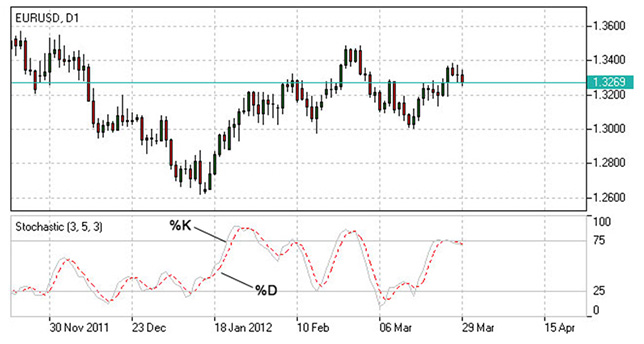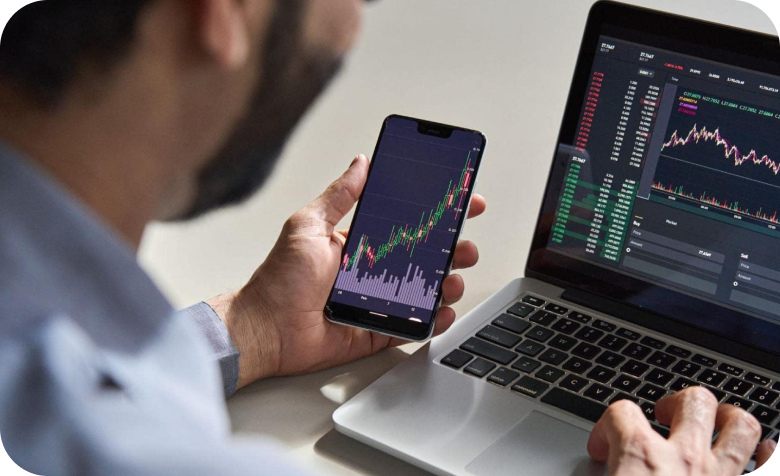- Education
- Forex Technical Analysis
- Technical Indicators
- Oscillators
- Stochastic Indicator
Stochastic Oscillator - Stochastic Indicator
What is Stochastic Indicator
How to use Stochastic Indicator in trading platform
How to Use Stochastic Oscillator
The Stochastic oscillator allows to identify possible overbought and oversold areas, but should be considered within trend analysis:
- Generally if the Stochastic Oscillator climbs above 75, the asset may be overbought;
- If the Stochastic Oscillator drops below 25, the asset may be oversold.
Leaving extreme areas the indicator may suggest possible turning points:
- Crossing the overbought boundary from above, the Stochastic signals a possible sell opportunity;
- Crossing the oversold boundary from below, the Stochastic signals a possible buy opportunity.
Crossovers of the indicator with its smoothened signal line, usually a 3-period moving average, may also detect deal opportunities:
- The Stochastic Oscillator suggests going long when crossing the signal line from below;
- The Stochastic Oscillator suggests going short when crossing the signal line from above.
Convergence/divergence patterns may indicate possible trend weakness:
- If the price climbs to a new high, but the indicator does not, that may be a sign of the uptrend weakness;
- If the price falls to a new low, but the indicator does not, that may be a sign of the downtrend weakness.

Stochastic Oscillator - Stochastic Indicator
Stochastic Oscillator Trading Strategy
Stochastic system is based on the observation that in an uptrend closing prices tend to be near the upper end of the price range, and in a downtrend the closing prices tend to be near the lower end of the price range.
In the Stochastic strategy two lines - the %K line and the %D line – are used. The K line is faster and the D line is slower. These lines oscillate from 0 to 100 on the vertical scale. The major signal to consider is the divergence between the D line and the price of the underlying market. When the D line is over 80 and forms two declining peaks with prices moving higher, a bearish divergence occurs. When the D line is below 20 and forms two rising bottoms with prices moving lower, a bullish divergence takes place. Thus, the actual buy and sell signals are triggered when the K line crosses the D line. A sell signal is generated when the K line crosses below the D line from above the 80 level. Accordingly, a buy signal is generated when the K line crosses above the D line bellow the 20 level.
Stochastic Oscillator Formula (Calculation)
The stochastic oscillator is calculated by dividing the difference between the last closing price and the low price over n periods into the difference between the high and low prices over n periods. To get an absolute range from 100 to 0, the fraction should be multiplied by 100. The number of time periods of the oscillator is set by a trader based on his trading strategy.
Stochastic = 100 x ((C – L)/(H – L)); Signal = average of the last three Stochastic values; where: C – latest close price; L – the lowest price over a given period; H – the highest price over a given period.
Forex Indicators FAQ
What is a Forex Indicator?
Forex technical analysis indicators are regularly used by traders to predict price movements in the Foreign Exchange market and thus increase the likelihood of making money in the Forex market. Forex indicators actually take into account the price and volume of a particular trading instrument for further market forecasting.
What are the Best Technical Indicators?
Technical analysis, which is often included in various trading strategies, cannot be considered separately from technical indicators. Some indicators are rarely used, while others are almost irreplaceable for many traders. We highlighted 5 the most popular technical analysis indicators: Moving average (MA), Exponential moving average (EMA), Stochastic oscillator, Bollinger bands, Moving average convergence divergence (MACD).
How to Use Technical Indicators?
Trading strategies usually require multiple technical analysis indicators to increase forecast accuracy. Lagging technical indicators show past trends, while leading indicators predict upcoming moves. When selecting trading indicators, also consider different types of charting tools, such as volume, momentum, volatility and trend indicators.
Do Indicators Work in Forex?
There are 2 types of indicators: lagging and leading. Lagging indicators base on past movements and market reversals, and are more effective when markets are trending strongly. Leading indicators try to predict the price moves and reversals in the future, they are used commonly in range trading, and since they produce many false signals, they are not suitable for trend trading.

Not sure about your Forex skills level?
Take a Test and We Will Help You With The Rest


